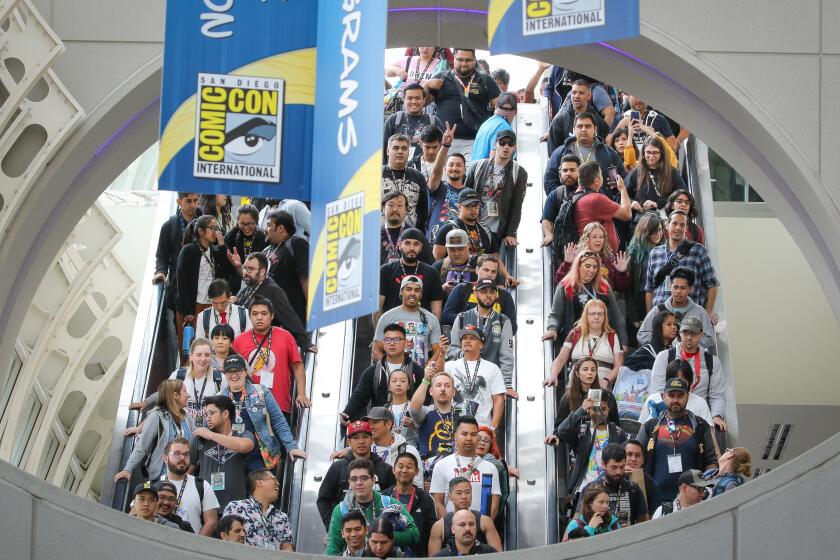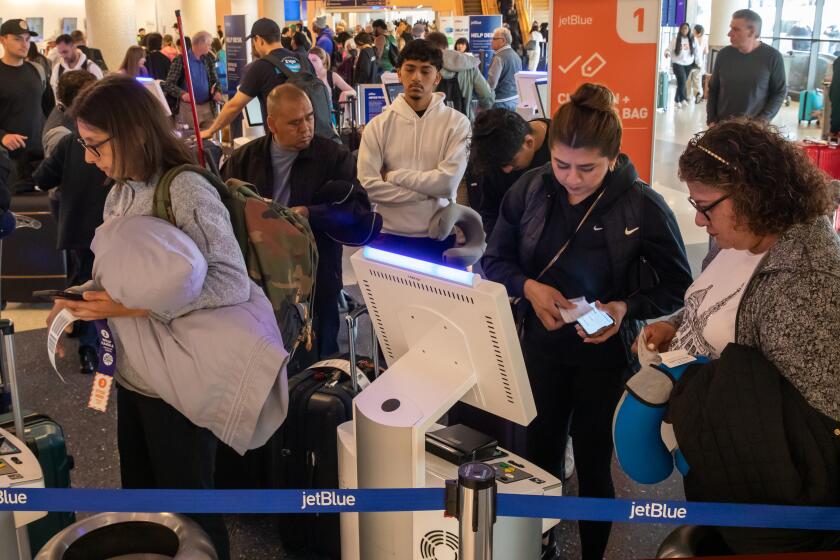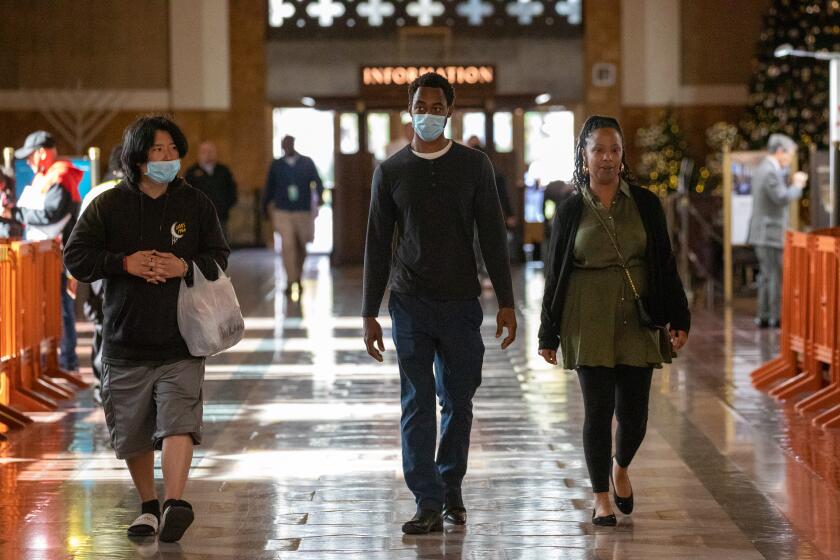COVID-19 is ‘heating up all around’ this summer. Should we be wearing masks again?

- Share via
The uptick in coronavirus transmission this summer has not brought major alarm from health experts.
But it is raising questions about whether the risks are high enough to go back to safety measures that many have abandoned.
Dr. Peter Chin-Hong, a UC San Francisco infectious diseases expert, said transmission is increasing and “we haven’t seen the crest yet” of the wave.
Most people have stopped wearing masks and aren’t likely to follow suggestions to return to that practice all the time again.
But swearing off masks for good — even when sitting on a plane next to someone who is coughing or sneezing — would unnecessarily put people at higher risk for illness.
“I think there’s, like, an in-between” message, Chin-Hong said. There are people who may want to avoid contracting COVID-19 “because it’s disruptive to life.”
Chin-Hong said he’s aware of people who’ve had to change big travel plans to Europe and Africa because of illness.
“Right now, when things are heating up all around the country with COVID, you might want to think about [masking at] public transit and airports,” Chin-Hong said. And even if you don’t choose to mask up, “definitely be kind to people who decide to wear masks.”
Summer has brought an uptick in coronavirus transmission, but experts say it is still too early to tell whether this represents a significant health concern.
In response to the latest uptick of coronavirus levels in California, a number of local health officials are largely reiterating the same advice: Masks work, but it’s a personal preference whether people wear them.
If you really don’t want to get sick — say you have an upcoming wedding or a long-planned vacation abroad — now might be a good time to mask up ahead of the big event, and at the very least, in the highest-risk situations, such as in a crowded room or on public transit.
Having test kits available should anyone feel sick is also a good idea.
And masking doesn’t need to be done all the time for it to make a difference.
Some health experts say they wear a mask when boarding or exiting a plane — when the air might be stuffy on a crowded jetway and the aircraft is parked at the gate — but not while sitting on the plane after the engines have revved up and the circulation system is at full power.
Still, with COVID-19 far less dangerous than earlier in the pandemic — thanks, in part, to vaccinations and anti-COVID drugs as well as immunity from past infections — it’s really up to people to decide for themselves.
Test positivity has ticked up in L.A. County in recent weeks, though we’re still well below peak COVID levels. If you get COVID now, here’s how to treat it, how long to isolate, how to get Paxlovid, and more information on getting healthy.
Coronavirus levels are ticking up, but overall rates are still quite low. Nationally, the number of new weekly COVID-19 hospitalizations has risen by roughly 12% each week over the last three weeks. But the most recent number — about 9,100 new COVID-19 hospitalizations for the week that ended July 29 — is still near a record low.
In California, coronavirus levels in wastewater in most parts of the state are now at a “medium” level; a week earlier, they were mostly at a “low” level, state epidemiologist Dr. Erica Pan said in a briefing to healthcare professionals Tuesday.
California’s test positivity rates have gone up in the last two to three weeks, “and I’m sure many of you are anecdotally both hearing about friends and family and colleagues ... about some more circulating COVID,” Pan said. “Thankfully, our hospitalizations are looking very reassuring so far.”
In California, the number of weekly COVID-19 hospitalizations rose by 4% for the week that ended July 29 compared with the prior week, when the week-over-week increase was 12%.
The end of the federal government’s health emergency has left COVID-conscious Americans feeling vulnerable. Here are some steps you can take to protect yourself.
Experts say it’s important to realize that COVID-19 hasn’t disappeared. Even though mortality rates have significantly fallen, it can still be a nasty illness and disruptive for some.
“Even though the declared emergency is over, COVID is still circulating — and it probably will be for quite some time. And so if you really don’t want to get sick, you can protect yourself by wearing a mask when you’re indoors,” said Dr. Sara Cody, the Santa Clara County public health director and health officer. “But it’s, at this point, an individual decision.”
Wearing masks, even only on occasion in the highest-risk environments, can help “because the more people are together, the greater the chance that one of those people is going to be infectious and spread COVID to others,” Cody said.
That advice hasn’t changed, even with the end of the pandemic emergency.
Cody fell ill with COVID-19 in February after eating in an indoor dining hall at her daughter’s college during a family weekend. Cody remembered pondering the risk at the time.
“I just stood out there and thought, like, if I go in and dine at this event, I’m at risk. On the other hand, if I go in with my mask, and don’t dine, that’s not going to be really lovely for my daughter,” she said. “And so I just thought about it, and I made a decision, you know: I just thought, for her, I’ll just take off my mask and go have lunch. And then I got COVID.
“I understood the risk. And I decided that for this particular event that was very meaningful to my daughter, that I dined like every other parent, I decided it was worth the risk.”
Cody said that after that experience, she generally keeps her mask on in indoor public venues, but “if there’s a social event where I think it’s really, really important to me, and if it’s not too crowded, and the ventilation seems OK, I might make an exception.”
New study suggests that people with a specific version of a particular gene who got COVID were far more likely to experience an asymptomatic infection.
For people who have stopped masking amid record low coronavirus levels earlier this year and don’t want to risk getting sick, Cody said to consider masking in higher-risk settings.
With transmission “creeping up, the chance that you get COVID if you’re not masking indoors is creeping up. And so it depends on how much that matters to you,” she said. “And, of course, if I was someone who had an underlying health condition, I would accept a whole lot less risk. And I would be very careful to mask.”
In Los Angeles County, the local Department of Public Health’s guidance maintains that masking for the general public is based on individual preference. L.A. County currently has a low level of COVID-19 hospitalizations as defined by the U.S. Centers for Disease Control and Prevention. This is the case for all counties in California and most nationwide.
“Everyone is encouraged to make an individual choice about whether to wear a mask or not based on their individual risk factors, risk levels of close family or friends they spend time with, and the nature of the event or location,” the L.A. County Department of Public Health said in a statement.
“For people who are at higher risk for severe illness, or live with someone who is at higher risk for severe illness, they may want to consider wearing a mask in large indoor gatherings with a lot of people. No person should be prevented from wearing a mask as a condition of participation in an activity or entry into a business.”
L.A. County still strongly recommends masking on public transit, in transportation hubs such as airports, among patients and visitors in healthcare settings, among people exposed to COVID-19 and among those who have symptoms of respiratory illness.
Healthcare workers in L.A. County are still required to wear masks when providing care or working with patients and clients.
Staying up to date on vaccinations is also an important factor in protection. People who have not received an updated shot since the September 2022 boosters that were designed to protect against Omicron subvariants BA.5 and BA.4 are overdue for one.
And seniors, as well as immunocompromised people, who got a COVID-19 vaccination last autumn or winter became eligible in April for a second updated booster — as long as four months had passed since their initial one.
“Currently, we do not expect more severe disease or hospitalizations for people who are up to date on their vaccinations,” the San Francisco Department of Public Health said in a statement to The Times.
If you aren’t up to date on shots and are immunocompromised or older, Chin-Hong suggests you get the 2022 version of the shot now — and not wait for the autumn 2023 formula — given that COVID-19 levels are rising.
“I’m just worried about them getting very sick,” Chin-Hong said.
More to Read
Sign up for Essential California
The most important California stories and recommendations in your inbox every morning.
You may occasionally receive promotional content from the Los Angeles Times.















